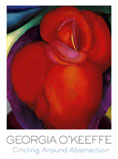
When the International Exhibition of Modern Art (now commonly known as the Armory Show) opened in New York in 1913, it provided American audiences with a controversial, highly publicized introduction to the latest trends in modern art-in particular the bold advances of European movements such as Fauvism, Cubism, and Futurism. Only a few American artists had begun to experiment with abstraction prior to the Armory Show, but the show's impact was so great that many more chose to do so in its wake.
To understand fully just how distinctive O'Keeffe's abstractions were, it is informative to compare them with paintings by some of her contemporaries. Most lack the organic fluidity of O'Keeffe's compositions; circular forms are not used as often or as inventively. Marsden Hartley, for example, created a colorful symbolic language to express his feelings about America and his recently deceased friend Karl von Freyburg. Manierre Dawson reduced his subjects to loose grids of lines and overlapping planes. The Synchromists Stanton Macdonald-Wright and Morgan Russell combined the fractured forms of Cubism with prismatic color to create their luminous canvases. Even Arthur Dove, the artist to whom O'Keeffe is most often compared, had not yet settled upon a form as resonant for him as O'Keeffe's spirals and whorls were for her.

